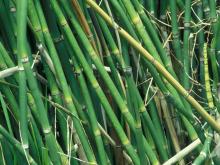Wildflowers, Grasses and Other Nonwoody Plants
Media

Species Types
Scientific Name
Equisetum (3 spp. in Missouri)
Description
Horsetails, or scouring rushes, are in the genus Equisetum. They’re easy to recognize with their jointed, hollow stems. Like ferns, they reproduce via spores instead of flowers and seeds.
Media

Species Types
Scientific Name
Asplenium platyneuron
Description
Ebony spleenwort is a common forest-floor fern with wiry, shiny, dark brown leaf stalks and a ladderlike series of dark green, narrowly oblong leaflets.
Media

Species Types
Scientific Name
Cystopteris protrusa (formerly C. fragilis var. protrusa)
Description
Lowland brittle fern, also called southern fragile fern, is an easily recognized species. It’s a common springtime sight in moist forest soils.
Media

Species Types
Scientific Name
Ophioglossum spp.
Description
Four species of adder’s tongue ferns occur in Missouri. They don’t look like typical ferns. They have spoon-shaped leaves and an upright spore-bearing stalk.
See Also
About Wildflowers, Grasses and Other Nonwoody Plants in Missouri
A very simple way of thinking about the green world is to divide the vascular plants into two groups: woody and nonwoody (or herbaceous). But this is an artificial division; many plant families include some species that are woody and some that are not. The diversity of nonwoody vascular plants is staggering! Think of all the ferns, grasses, sedges, lilies, peas, sunflowers, nightshades, milkweeds, mustards, mints, and mallows — weeds and wildflowers — and many more!





















